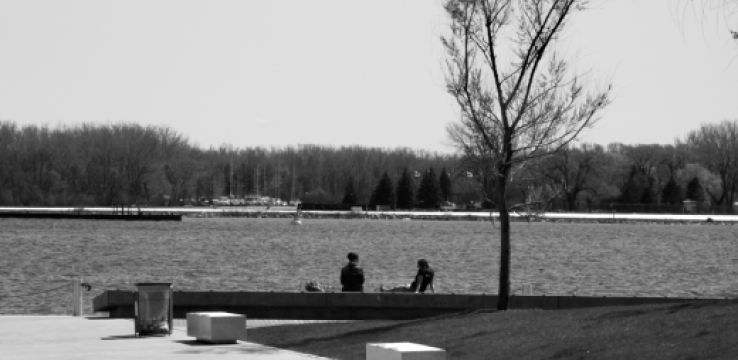Little things matter. In Toronto, where Jane Jacobs constantly reminded planners and developers that their big projects didn’t fit the people who would live and work in them, there remains a celebration of neighborhood scale, charm and quirkiness. Chinatown, Kensington Market and Baldwin Village have much of the distinctive character of San Francisco’s Chinatown, North Beach and Noe Valley.
As Toronto struggles out of a decade of political amalgamation, a shrunken municipal staff and smaller budgets, plus a huge transfer of social-service responsibilities from the province to the city, Elyse Parker has been watching the little things, citywide.
Parker is the project manager of Toronto’s Clean & Beautiful City Secretariat, one of the high-profile initiatives of the popular, two-term mayor, David Miller. By 2004, Toronto had become, in the mayor’s words, “frayed and uncared for” following itsforced amalgamation of seven municipalities in 1998, and a rushed reconfiguration of political, financial and managerial structures. Basic city services suffered as departments downsized. Even as the real-estate market boomed, new buildings lacked design distinction and streets lacked the grace that attracts pedestrians.
In his first term, Miller decided to make Clean & Beautiful a civic strategy. That adoption of an overarching paradigm is the difference between Toronto’s approach to tidiness, and that of most other cities. In San Francisco, Mayor Gavin Newsom is using the BlueGreenway, an extension of the Bay Trail that circumscribes the rest of the city’s shoreline, as an element in the revitalization of the Eastern Neighborhoods and Bayview-Hunters Point. Toronto Clean and Beautiful, on the other hand, is a citywide “commitment to the public realm.”
It began with an action plan of five elements, understandable at grade-school level: Sweep It, Design It, Grow It, Build It, Celebrate It. They could have added a sixth: Fund It. Instead, that was tucked into Design It.
Much that was done was simple, and would be familiar to anyone who has seen similar efforts elsewhere. The first phase was to dig Toronto out of its dirty hole and clean it up. The city added millions to its upkeep budgets and focused on 10 steps for better performance — and, critically, better coordination — among key departments. The targets were the usual quality-of-life issues: litter, weeds, graffiti, dumping and street cleaning. Miller mobilized private sponsorship and community support for an annual “20 Minute Toronto Makeover,” which had 44,000 participants picking up litter. By 2006, Miller’s campaign for a second term trumpeted that “litter has been reduced by 40% since 2002” (www.toronto.ca/mayor_miller/pdf/miller_platform_webed_screen.pdf.)
Phase Two was more ambitious. New street furniture gained a coordinated design. Three agencies had their responsibilities for litter and sign enforcement integrated and harmonized. Four significant public beautification projects were designated at prominent gateway locations. An upgrade program began to restore city parks (it tells you something of their state that the first priority was to increase grass cutting). A professional design-review panel was created to “raise the bar on (development) design.” A competition was organized to redesign Nathan Phillips Square, Toronto’s equivalent of San Francisco’s Civic Center. Two avenue studies began, to intensify development on important thoroughfares that have the transit and public infrastructure that can accommodate growth. Owners of commercial buildings in key areas received grants to renovate their façades. The city began a Festival of Architecture and Design each May. Even the city models in City Hall were repaired and updated. In all, there were 48 initiatives.
Perhaps the most interesting of those initiatives was Orphan Spaces. Parker, a graphic designer with a keen eye for design and detail, had noticed the leftover bits and pieces that every city has in abundance. That triangle of curbed, crumbled concrete with a traffic sign, where a lane branches from a road. The dirt and dead plants that lie between a sidewalk and the curb. The blank walls that so often meet, and deaden, the streets. Many of the orphans were city property, often not a priority of the transportation or works departments. Clean & Beautiful Toronto made those spaces a priority. By 2008, the city was cleaning up 360 of them. For private properties, a mural-grant program encourages a transformation from bland to lively.
Parker says, “Seeing the city’s orphan spaces can become an obsession. There is always something I see that can be fixed or improved.”
As you walk around San Francisco, see how many orphan spaces you can find. It’s quite amazing how many there are. Take pictures, too. Imagine how these spots of ugliness could be transformed, and how that would affect the feel of their surroundings.
Little plans may not have “the magic to stir men’s blood,” as Daniel H. Burnham put it, but a big, strategic plan for many little things can be magical.
Orphan spaces thrive when neighborhoods and citizens adopt them. After a very difficult decade of political turmoil and deficit budgets, the initiative is helping to make residents who often thought of themselves as from York, East or North York, Scarborough, or Etobicoke — the amalgamated cities — into proud and caring Torontonians.
